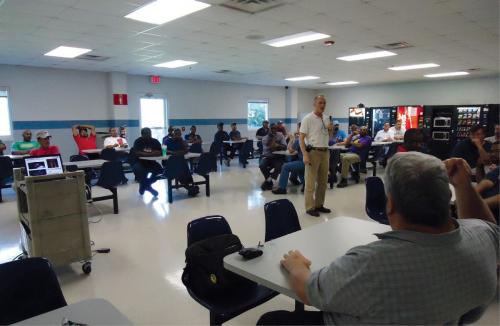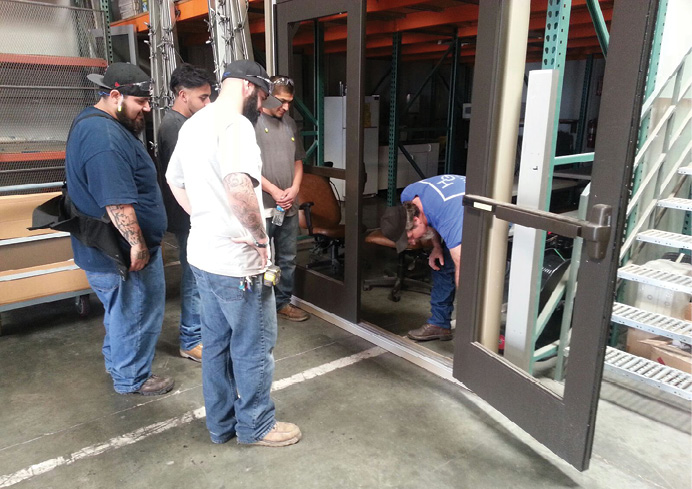Set Up for Success
To cultivate quality, long-term employees, invest in getting the onboarding process right

A group of new Viracon employees being taught how to safely handle and lift glass.

Onboarding, or the process of preparing new employees for job success, is vital for employee integration and retention. According to a 2007 study by the Wynhurst Group, when employees go through structured onboarding, they are 58 percent more likely to remain with the organization after three years. An onboarding program is an investment in a quality, long-term workforce. To be effective, sources say, onboarding should be an intentional and ongoing process with each new hire.
“Onboarding is not just the employees’ first day, first week or first month, but an ongoing process for months thereafter,” says Laura Klee, vice president, human resources, Consolidated Glass Holdings. “The better we can be at the process, the more successful our new hires will be.”
“Onboarding within every department, every facility is to empower people. We want to have them here, to be a part of … our culture,” says Sherri Blackledge, human resources manager for YKK AP America Inc. “Every position is critical to the overall success of our company. If employees come in wanting to do their job, it’s a win-win no matter the position.”
Onboarding encompasses orientation, paperwork, safety training, reviews, skills training, mentoring and career development. Setting up a new employee for success starts with shaping their place within the larger company culture, by communicating what they do and why they do it.
“I want employees to know that they have a future. I want to articulate why they’re doing certain tasks, why they’re watching the safety videos—why it’s important. We’re communicating that we care about them and want them to be successful,” says Bill Sullivan, president, Brin Glass Co.
In addition to well-trained employees and increased retention, long-term benefits of a structured, effective onboarding process include reduced time to productivity and better overall customer satisfaction, according to Talya Bauer, Ph.D., writing for the Society for Human Resource Management. It is vital within the first few months on the job, as 22 percent of staff turnover occurs in the first 45 days of employment, according to the Wynhurst study, and nearly half of new hires fail within the first 18 months, according to a Leadership IQ study, of 20,000 new hires.
“A better trained, engaged workforce that holds our values creates a better experience for our clients,” says Sullivan. “Structured onboarding can get everyone to buy in, and think the same way about customer service.”
“An engaged employee will show up. We’re creating loyalty [with onboarding]. When you don’t have those people, it can disrupt numbers, affect your output. It becomes pragmatic if we can’t get people connected to the organization, connected to who we are,” says Blackledge.
This article details what a carefully planned and effective onboarding process looks like, and how companies can leverage the onboarding process to set up new hires for success, through resources, subject matter knowledge, clear expectations and training.

Greg Hultquist (standing), vice president of manufacturing at YKK AP, conducts a quarterly communication meeting with all employees.
Hire for fit, train for success
The lack of skilled labor in an already shallow labor pool within the construction industry is no surprise to glass industry companies. But understanding how to combat this challenge coupled with a changing multi-generational workforce is an ongoing learning process.
“The industry’s number one challenge is lack of skilled labor. We’ve always done some level of education, but now we find ourselves bringing in complete trainees,” says Brian Hale, chief operating officer of Hale Glass Inc. “We’ve substantially raised our hourly rate to attract more qualified candidates, especially millennials, and compete with everyone else who’s struggling.”
Ultimately, the current workforce challenges necessitate that industry companies rethink recruitment and hiring practices, and even rethink the definition of a quality candidate.
Recruitment
“Longevity and specific skillsets used to be the [ideal] when reviewing resumés,” says YKK AP’s Blackledge. “[Now] you may have to be more open minded to job changes, especially in the younger generation. We might have to give half of what they need in terms of skills training. [Additionally], looking at parallel industries was not done 10 to 15 years ago. Now when looking at resumés companies should be open to asking: ‘do they show evidence of the right kind of skillsets where we can train them for the job?’”
For Brin Glass, the hardest aspect of the labor shortage is recruiting new workers and replacing retiring workers. Sullivan says finding workers has become a large part of his daily job. “Young people aren’t getting into trades, and it’s an increasing challenge to find quality people who can pass a drug test and want to work more than short term.”
Brin is working to hire a dedicated human resources manager to tackle the onboarding process in light of these challenges. “With this person in place, we hope to develop a pipeline with tech schools and high schools to find recruits,” says Sullivan.
Hale Glass offers a finders’ fee for an employee who brings on a new recruit if they stay for 90 days. “We approach anybody anywhere that looks like a good candidate,” says Hale. “Our growth is stymied because there’s so much work and not enough people.”

Hale Glass runs a yearly five-week training program, Teach Our People. Here, employees learn how to hang doors. The doors and jambs are in a permanent frame, and can be taken out and rehung as needed for training.
Training
Because industry companies are hiring outside normal parameters, training is more vital than ever. And, while not the whole of it, training is an important part of the overall onboarding process.
“If we could hire the perfect person, that’d be great. But there are pitfalls, and we have to recognize, address and handle them,” says Blackledge. “Part of this is making sure management is prepared for training, and constantly asking: ‘how can we grow the company and develop people for the benefit of everyone?’”
Hale Glass needs more workers in the field. But to tailor its training initiatives to the workers’ abilities and the type of job, managers pull new hires back into the shop for monthly, targeted subject matter conversations. “It’s our opportunity to formalize why they’re doing a task. We still take time to train, but occasionally address what they did in the field in a short conversation,” says Hale. “Whatever the job dictates, they will be exposed to it in the field before we talk about what they’ve been doing and why.”
Also in the shop, new hires are exposed to raw materials to understand glass from the ground up. Hale trainers describe the ingredients of glass, define the float process, explain fabrication processes, discuss how glass is made, and offer fun facts about glass and the glass industry. “We offer them opportunities to learn and advance. Then they’re expected to perform,” says Hale.
Through its Train the Trainer program, Glass Doctor, has big expectations for both the trainer and the trainee, who are evaluated throughout the training process. “The development of skillset determines how successful the trainer,” says Tommy Patterson, director of product development and technical services, Glass Doctor.
Train the Trainer prepares its management for training new hires, especially those who lack basic skills. “For this business to endure, I don’t see any other option than to train young people with good work ethic and compatible personality, who want to learn a skill,” says Patterson. “We train internally and create a well-trained pipeline. It’s an apprentice-style training model.”
Glass Doctor’s Train the Trainer program, like all onboarding efforts, is an investment. But, Patterson says it’s more than worth it. “A lack of patience put [the industry] in this bad position,” says Patterson. “Taking the best people away from jobs to train the new guy is a hit to our productivity and payroll. But in the end, you can hire an expensive, trained person, or an inexperienced person who is trainable to your way of doing things.”
Four years ago, Viracon initiated a Training Within Industry program to specify training to each job. They analyzed every job, broke down tasks, and compiled training plans—200 of them—based on each job throughout its manufacturing plants. The plans include hands-on and classroom training experience.
Department training managers assess progress based on a new hire’s advancement through the training plan. “If a trainee is struggling, production shift trainers spend one-on-one time with them to work through problem areas, and are tasked to follow up with a new hire within the first five weeks,” says Jesse Josie, manager, human resources, Viracon.
Perfect the basics
Alongside training, basic steps such as proper job descriptions, complete paperwork and company orientation build an effective onboarding process to ensure every new hire understands the company and their place in it.
Expectations
“The main goal of onboarding is to empower,” says Blackledge. “We want to make sure [new hires] have a full understanding of the company [and] what’s expected from a policy, safety, environment standpoint. That initial time is for guidance and instruction, to empower how to do the job successfully.”
Communicating clearly defined expectations and knowledge of the company is possible by refining the basics, including paperwork, regular communication and tracking, and implementing them consistently, sources say.
During its 30-60-90-day review process, YKK AP is dedicated to communicating areas of strength and improvement, “for new people to have a grounded understanding of expectations and if they are meeting them,” says Blackledge. “Are they doing the job, doing it up to expectations, and are they comfortable?”
Viracon holds safety pride meetings, where manufacturing workers meet with supervisors and managers to go over what they’re working on for the day. “These onboarding steps keep the person engaged. It’s our opportunity to highlight the strengths of being a glass team member,” says Alicia Westendorf, training manager at Viracon.
Materials
By investing more time and attention to each process within onboarding, Viracon has seen a marked increase in safety. “We used to see lots of injuries coming from people here zero to three months,” says Westendorf. “[Onboarding] increases job knowledge and confidence in performing a task. It builds companionship.”
Part of its onboarding process is making sure training materials and mentors are accessible for all employees. Two of the company’s production shift trainers are bilingual—one in Spanish and one in Somali—to meet Viracon employee needs. The company also offers its training videos in English, Spanish and Somali. “Some resources are hard to translate, so we’ve also developed visual materials, and we use pictures to help everyone understand the concepts,” says Westendorf.
Determining when enough is enough is also an important piece of the onboarding process, Westendorf notes, particularly within the first two weeks. “Untrained employees are not as safe, productive or happy as those who are well prepared. But there’s a fine line between essential info and overload,” says Westendorf. “We’re working on managing that fine line, asking what is essential for them to know to do their job.”
Position requirements
“There’s a connection between poor training and non-success,” says CGH’s Klee. “We’ve spent more time and examined this connection over the past several years to develop tools and a review process to oversee new hires, discuss areas of improvement, and help them be successful in their position.”
One example of a basic step that CGH has mastered is its development of core training templates. These specialized, departmentalized templates spell out the safety needs and gear, specific tools, skills, paperwork of each position within the company. Now, the team is working to ensure the templates are standard across the group. “The templates help with training for the company and for our employees, so they really know their job.”
To take this process a step further, CGH is implementing a more streamlined and strategic approach to its onboarding program in January 2018, which will highlight the best practices across the group of companies.
Maximize employee involvement
Much of onboarding is ensuring new employees understand their job and its function in the company at large. However, this process doesn’t end after the 90-day review. While new employees may be officially onboarded at that time, feeling a necessary part of something to remain motivated, productive and loyal takes an ongoing commitment from both parties, sources say. Open and honest communication with all employees is a vital part of onboarding and long-term loyalty, they say.
Part of Brin Glass’ fight to keep workers long term has been giving lower level employees a seat at the table. In the past, managers met monthly and quarterly to discuss problem areas and successes. “That group has been expanded to include entry-level employees to get their input, get them more involved in decision making. They have a voice. That’s an incentive to stay here,” says Sullivan.
YKK AP’s vice president of manufacturing holds communication meetings with all workers in the plant. These meetings present the same message to every employee, no matter their tenure or position. “[In these meetings] they learn more about the company, more information on production, where we are in our numbers,” says Blackledge. “Continuous education is not just about skillset. It’s about the full scope of things.”
Viracon ties upward movement to its training plans. When employees complete a certain part of the training plan, they move up a step in Viracon’s wage plan. “In order to move up to the next knowledge-based pay level, employees complete their entire training plan, and are audited on their skills,” says Westendorf. “It levels the playing field, and bases movement directly to the training plan.”
Ultimately, the onboarding process is an investment in people. And while not a guarantee, investing in people breeds loyalty, and sets everyone up for long-term success. Clearly defined education and career development opportunities for all employment levels is part of that investment. “These programs are so important for keeping people here,” says Blackledge. “It’s important to articulate what employees need to do, to have a clearly defined progression program. We want everyone to perform well. Hopefully we can guide them to be successful.”
Onboarding Process
Editor’s Note: This information is a compilation of onboarding steps used by the National Glass Association, YKK AP America Inc., Brin Glass Co. and Viracon. It is intended to be used as a reference and adapted to individual company needs. It is advised that any company looking to implement formal onboarding steps consult a human resources expert or a lawyer.
Orientation
Manufacturing orientation typically lasts one or two days. New hires receive all introductory company and human resources information, and are introduced to plant safety and their personal job role.
- Review benefits packet and presentation
- Review employee handbook
- Hand out badges
- Review policies and dress code
- Review facility information
- Hand out manager/employee checklist to review fundamental new things an employee should know
- Introduce the company (products, culture, history, etc.)
- Begin safety training
- Tour facilities
- Secure and file required tax/legal paperwork and forms
- Review HR and administration roles
- Setup employee in payroll system
- Explain onboarding and training process, including check-in discussions
First two weeks
- Review safety, environment standards (ongoing)
- Introduce the basics of glass
- Review and explain job description
- Discuss training process, expectations (ongoing)
- Pair new employee with experienced person/mentor to assist with training
- Schedule 30-60-90-day check-in discussions
30-60-90-day check-in documentation outlines benchmark goals for an employee’s first three months at a company. It outlines expectations and provides guidance on training. The monthly check-in discussions assess each employee in areas of: quality of work, safety habits, advancement possibilities, attendance and behaviors.
First 30 days
- Develop goals and priorities for each week
- Meet with new hire for first monthly check-in
- Deliver informal initial feedback
- Continue job-specific training
Through the first few weeks, new hires receive hands-on and classroom training. If struggling, the new hire could receive one-on-one training, specific to problem areas.
First 60 days
- Meet with new hire for second monthly check-in
- Deliver informal feedback
- Continue job specific training
- Verify employee is enrolled in benefits
- Revisit job description
First 90 days
- Meet with new hire for third monthly check-in
- Update goals and priorities
- Gather feedback on the onboarding and training process
If the employee needs more specific job skills and training, assess and address those needs now. Consider extending this training period an additional 30 days.




